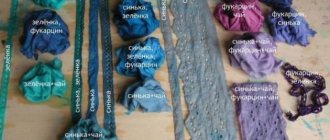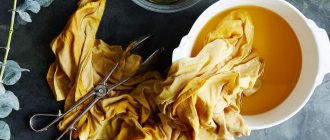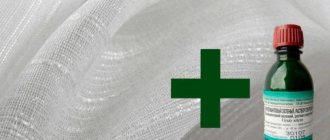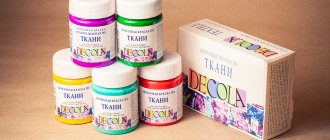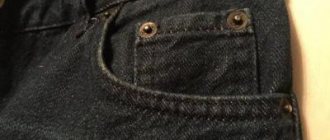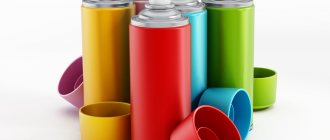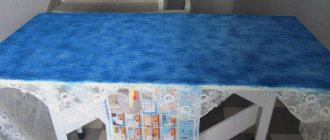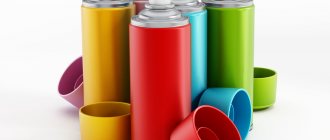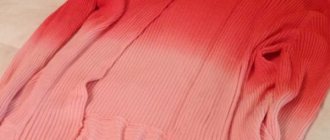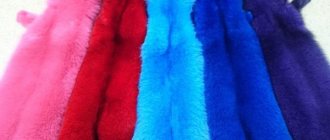Preparing for painting
Before you start work, you need to prepare everything you need, namely:
- things intended for dyeing;
- container and devices for turning fabric;
- dyes and rinses.
How to properly prepare clothes for dyeing
Before painting, you will have to remove the fittings from the clothing.
- First of all, you should wash your clothes thoroughly. If there are old stains on the fabric from grease, oil or other difficult-to-remove substances, you should definitely get rid of them. Otherwise, the fabric in this place will be dyed unevenly, and clearly visible stains will remain, which will greatly spoil the appearance of the product.
- Then you will have to remove the accessories - cut off buttons and decorations, flog metal zippers, since the surface of these parts can be damaged when painted and subsequently become covered with rust.
- If you decide to dye a new product made of cotton or linen, you need to remove the layer of starch that the manufacturer usually impregnates such fabrics with. To do this, prepare a soap solution, add a little soda and boil the clothes for 25 minutes, after which they rinse thoroughly.
- When dyeing wool yarn, you need to make sure that the threads do not intertwine or get tangled. To do this, it is divided into small parts and collected into loose skeins, which are tied in two or three places with twine.
Selecting containers and equipment for coloring
Once the clothes are prepared for dyeing, you can begin choosing a container.
- Any clean utensil will do, be it an enamel basin or an aluminum pan. The main thing is that there are no traces of scale or soot on the inner surface of the metal.
- Particular attention should be paid to the size of the container. The pan should be of such a volume that the thing to be painted is located freely in the solution, does not squash and does not rise above the surface of the water.
To stir and turn the product while working, you will need wooden tongs. If you don’t have such a device on your farm, you can use ordinary wooden sticks, after first clearing the surface of knots and uneven surfaces.
It is better to take soft water for the procedure, for example, rain or melt water. If this is not possible, then ordinary tap water can be softened with baking soda, for which 1 tbsp. l. powder is dissolved in 10 liters of water.
How to paint a product yourself
The choice of paint depends on the composition of the fabric and the preferences of the owner of the clothing.
Textile paint is available in the following forms:
- aerosol,
- pastes,
- powder.
It is suitable for use when dyeing by hand or in a washing machine. The choice of dye depends on the composition of the fabric and the personal preferences of the owner of the clothing.
Before starting work, it is necessary to accurately determine the composition of the product. If the label is erased or lost and it is not possible to find out reliable information about the composition, you can set fire to the thread from the product. Synthetic and natural fibers release different “flavors” when burned:
- synthetics smell like chemicals;
- natural wool or cotton emits the smell of burnt hair.
The easiest way to repaint a thing is from natural materials. Synthetics are difficult to paint and quickly lose their newly acquired shade.
The general rules for using universal fabric paint are the same regardless of the manufacturer of the product. However, when starting coloring, it would be useful to study the instructions included with the product in order to know exactly the dosage and nuances of using a particular dye.
Important! All work with the dye must be carried out with rubber gloves.
If the dye does not require heating the water, then it is better to carry out the work in the bathroom, having previously protected easily soiled items with waterproof film. Then the following activities are carried out:
- Pour paint into a container with warm water and stir thoroughly. The amount of water and dye is determined in advance depending on the weight of the clothing and the dosage indicated by the manufacturer on the packaging.
- The product is dipped into the solution and left for half an hour, stirring occasionally and making sure that the fabric does not wrinkle.
- As soon as the product acquires an intense black color, it can be removed from the solution and rinsed in cool water, adding 1 tbsp. l. vinegar.
Important! If you need to paint several things, you need to paint them one by one.
Often the instructions require heating the coloring solution, then proceed as follows:
- The container with paint dissolved in water is placed on low heat and heated to a temperature of 60 °C.
Important! When dyeing wool and silk, add 50 ml of 25% vinegar essence to the solution.
- The item prepared for painting is immersed in a hot solution for an hour, maintaining a constant temperature of no more than 60 ° C and stirring occasionally.
- After the allotted time has passed, the product is washed in a machine or by hand at a water temperature of 40 ° C and rinsed with the addition of vinegar.
In the future, you should wash and rinse items painted black separately from the rest of your clothes, and add vinegar to each rinse.
Origins of ancient art
The art of dyeing canvases, which our ancestors mastered perfectly, originated in ancient times in the countries of Asia and the East, and then spread throughout the world. The skill of ancient craftsmen made it possible to obtain over eight hundred shades of the color spectrum based on only a few dozen natural dyes. The secret of the diversity of the color palette was the interaction of dyes with salts of various metals (mordants). The subtleties of the dyeing process were kept secret by the masters, and the traditions of the unique craft were passed on from generation to generation.
With the development of textile manufacturing and the advent of the first synthetic dyes, natural dyeing gradually disappeared from the practice of textile processing, and many recipes were lost or consigned to oblivion.
Dyeing in the washing machine
For dyeing, the washing machine is set to a washing mode in which the cycle duration does not exceed 30 minutes.
You can use a washing machine to dye clothes. Modern dyes have compositions that are completely safe for the operation of household appliances, and the process itself is easier and faster than manually.
- Pour 0.5 liters of hot water into the container and pour out one package of dye. Mix thoroughly, trying to dissolve all grains of powder and obtain a homogeneous mixture.
- Things are turned inside out and loaded into the washing machine. When dyeing, do not use washing powder or conditioner.
- A dye is poured into the machine. You can simply tear the paint bags and put them on top of your clothes.
- When dyeing silk or other delicate fabrics, add 150 ml of 25% vinegar essence.
- Set the washing mode in which the water temperature does not rise above 60 ° C and the cycle duration is no more than 30 minutes, including rinsing.
- After dyeing is completed, wash again at a temperature of 40 ° C, which will allow the paint to adhere well.
The products are dried by laying them out on a horizontal surface away from radiators and avoiding direct sunlight.
To completely clean the machine drum of traces of dye, you need to carry out one cycle in the “rinse” mode using chlorine bleach.
Natural eco-dyes for fabrics
Multi-colored nature offers a whole string of its gifts suitable for dyeing textiles. First, let's figure out what natural dyes can be used to realize the desired color palette.
- Yellow color - solar dyes can be obtained from citrus fruits, calendula flowers, dandelion and St. John's wort, barberry roots and wood, and fresh buckthorn bark. Birch leaves and turmeric will provide a rich yellow tint, and a decoction of wormwood will provide a delicate straw color. The orange color comes from plantain seeds and sea buckthorn berries.
- Brown dye is produced by dry bark of buckthorn, oak, horse sorrel roots, and goldenrod shoots. A decoction of onion peels allows you to get beautiful red-brown and bronze shades.
- Deep blue and soft blue shades can be obtained by coloring blackberry fruits, inflorescences of Ivana da Marya and meadow sage. Violet tones of varying intensity are achievable using cornflower and purple iris petals, red cabbage, dogwood bark and blueberries.
- Green dyes – soft pastel green dyes can be obtained from spinach leaves, elderberries, sorrel root and artichokes. a beautiful herbal shade.
- Coffee and tea of varying concentrations are colored in pastel cream and beige
- Pink natural dye in various shades is obtained from strawberries and raspberries, and fir bark. Red pigment is produced by young branches of buckthorn, wild poppy flowers, ripe elderberries, and madder roots.
Collecting herbs, fruits and roots for dyeing can be done all year round.
Natural dyes
In addition to aniline and acrylic dyes, there are natural dyes, which are ordinary products. You can dye the product black using coffee, tobacco or hair dye:
- Coffee will help restore the intense black color of fabric that has lost its original appearance. To dye, you need to prepare enough instant or boiled coffee so that the liquid can cover the item being dyed. The stronger the drink, the brighter the color of the fabric. The coffee is brought to a boil, removed from the heat, and the item prepared for painting is immersed in a pan for an hour. The longer the fabric is in the solution, the more colored the fibers will be.
- Instead of coffee, you can take tobacco. To prepare a dyeing solution, pour 15 g of tobacco into 1 liter of water and boil it, after which the product intended for painting is immersed in the container.
Designers using henna
The method of dyeing jeans with henna was quite common during the hippie era. It was these peace-loving guys and girls who discovered henna as a product that could be used as a dye for things. Of course, back then it was more of a way out of a difficult situation; I wanted to diversify my jeans, and henna was at hand.
But now it has become a real highlight of many celebrities, for example, Jessica Alba and Will Smith admitted that they did this with their clothes in their youth. Taking up this idea, many designers began to use henna as a means of dyeing fabrics. But it is best to apply henna on items made of denim; the creators of the German denim brand Carat Design Jeans, which, by the way, is against environmental pollution, learned this long ago.
By releasing such a line, the company killed two birds with one stone - it generated enormous interest in itself by using this technology, and began to promote this line as absolutely harmless. After all, henna is a pure and safe plant for others.
Useful tips
For those people who don't often dye items from their wardrobe, the helpful tips and tricks listed below can come in handy.
- If you have to paint a product for the first time, it is better to practice on an old unnecessary thing that you don’t mind throwing away if it fails.
- To accurately determine the required amount of dye, the textiles must be weighed.
- If the item to be repainted is intended to be remade, then it should be torn into pieces in advance.
- Uneven coloring of synthetic fabric can be corrected by immersing the product in a hot soapy solution.
- Items dyed black should be washed separately from other clothes. The fact is that they can fade and ruin all the other things in the drum.
Dyeing your favorite clothes black, done at home, will not only return the items to a bright, rich color, but will also save time and money. The main thing is to buy paint from trusted manufacturers, follow the instructions and listen to the advice of experienced housewives.
Eco-print or contact dyeing technique
Recently, an amazing technique for obtaining natural patterns and plant imprints on canvas has been gaining popularity. Elegant scarves, napkins, tunics, dresses and coats in eco-style are painted with magical designs. Some craftswomen sew exclusive clothes to order.
There are several ways to apply natural ornaments:
- The easiest way to apply an eco print is to transfer the leaves and inflorescences of plants onto the fabric using a hammer. We place the selected element on the fabric, cover it with parchment paper and beat it with a hammer so that the colors of the plant are absorbed into the textile.
- “Hot” eco print. Leaves, twigs and flower petals are placed on the fabric, rolled into a bundle and persistently simmered over low heat or exposed to a press and steam. The result is real natural magic!
Natural dyeing is a wonderful way to decorate clothes, to make an ordinary item original, updated and bright.
